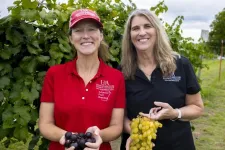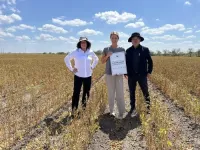(Press-News.org) Sea otters are famed for their luscious pelts, but the fur almost led to their extinction. By 1938, only a tiny population of ~50 remained clinging to the central California coast. Since then, the mammals have battled back; however, the charismatic creatures are still at risk from crude oil spilled by offshore rigs. But no one knew how severely crude oil impacts the buoyancy of sea otter fur or how well it recovers after cleaning. And Kate Riordan from California Polytechnic State University San Luis Obispo (Cal Poly SLO), USA, adds that the fur of newborn sea otter pups was also believed to be particularly buoyant, but no one had checked. Curious to answer these questions, Riordan joined forces with Nicole Thometz (University of San Francisco, USA), Francesca Batac [California Department of Fish and Wildlife (CDFW), USA] and Heather Liwanag (Cal Poly SLO) to investigate. They publish their discovery in Journal of Experimental Biology that crude oil pollution dramatically reduces sea otter fur buoyancy, placing pups at particular risk thanks to their larger surface area relative to their body mass, and that the buoyancy does not fully recover, even after cleaning.
Sea otters in the wild die naturally for many reasons and are collected by the CDFW – which monitors the health of the population – so they passed on sections of a few precious pelts from southern sea otters ranging in age from tiny pups up to 9-year-old adults to Riordan, Annika Dean and Sarah Kerr (both from Cal Poly SLO). After cleaning the pelt, the team then weighed a 25 cm2 portion from each in air and in water to determine the fur’s buoyancy. However, when they compared the buoyancy of the youngsters’ pelts with that of the fully grown adults, there was no difference. All of the sea otter fur portions had a buoyancy of ~0.3 N, about the same as a 10 g piece of cork, so a sea otter pup’s fur is no more buoyant than the fur of its parents. However, when the team calculated the impact of the fur’s buoyancy on the pups’ entire bodies, the youngsters’ fur was almost three times more buoyant for their body mass than that of the adults, thanks to the pups’ relatively large surface areas for their size. This allows the pups to trap more air for their smaller body mass to make them extremely buoyant and keep them bobbing at the surface while mum’s off hunting.
But how did a dousing of crude oil affect the fur’s buoyancy? This time, the team massaged crude oil into the fur, mimicking how sea otters groom naturally – inadvertently rubbing the pollution into their pelts – before measuring the oil-sodden fur’s buoyancy. Sure enough, the fur’s buoyancy plummeted by almost 55% to 0.145 N, making it much more difficult for the animals to remain afloat. The reduction in buoyancy coupled with the loss of insulation would almost certainly prove fatal in the wild.
Fortunately, conservationists swoop in quickly in the event of major crude oil spills, drenching oil-soaked creatures in detergent to rid them of the oil, but how well does the buoyancy of sea otter fur recover after cleaning? Riordan and colleagues gently washed each oiled pelt with Dawn® Ultra Dishwashing Liquid, before rinsing thoroughly, finishing with a blow-dry and remeasuring the pelt’s buoyancy. As they had hoped, the buoyancy of the fur improved, but only by 36% to 0.197 N, still almost 40% down from the fur’s natural buoyancy.
The team suspects that living sea otters may recover better after cleaning because they groom continually, but they suggest that it is essential that detergent is thoroughly rinsed off after cleaning to ensure that oiled sea otters recover fully.
********************************************
IF REPORTING THIS STORY, PLEASE MENTION JOURNAL OF EXPERIMENTAL BIOLOGY AS THE SOURCE AND, IF REPORTING ONLINE, PLEASE CARRY A LINK TO: https://journals.biologists.com/jeb/article-lookup/doi/10.1242/jeb.247134
REFERENCE: Riordan, K., Dean, A. E., Kerr, S. J., Thometz, N. M., Batac, F. I. and Liwanag, H. E. M. (2024). A novel comparison of southern sea otter (Enhydra lutris nereis) fur buoyancy across ontogeny. J. Exp. Biol. 227, jeb247134. doi:10.1242/jeb.247134
DOI:10.1242/jeb.249406
Registered journalists can obtain a copy of the article under embargo from http://pr.biologists.com. Unregistered journalists can register at http://pr.biologists.com to access the embargoed content. The embargoed article can also be obtained from Jarren Kay (JEBNewsandViews@biologists.com)
This article is posted on this site to give advance access to other authorised media who may wish to report on this story. Full attribution is required and if reporting online a link to https://journals.biologists.com/jeb is also required. The story posted here is COPYRIGHTED. Advance permission is required before any and every reproduction of each article in full from permissions@biologists.com.
THIS ARTICLE IS EMBARGOED UNTIL THURSDAY, 12 SEPTEMBER 2024, 18:00 HRS EDT (23:00 HRS BST)
END
Semaglutide and tirzepatide treatment lead to significant weight loss and improve blood sugar control in individuals with type 1 diabetes (T1D) who are living with overweight or obesity, new research being presented at the annual meeting of the European Association for the Study of Diabetes (EASD) in Madrid, Spain (9-13 September) has found.
The two relatively new drugs are approved to treat type 2 diabetes and for weight loss. In type 2 diabetes, they help the body produce more insulin when needed. ...
Despite high use of continuous glucose monitoring and insulin pump therapy, fear of hypoglycaemia (low blood sugar) remains a significant barrier to physical activity and exercise for adults with type 1 diabetes (T1D), according to new research to be presented at this year’s Annual Meeting of The European Association for the Study of Diabetes (EASD), Madrid (9-13 Sept).
However, the findings suggest that if exercise and diabetes management are discussed in the clinic, this fear could be reduced.
“Regular exercise can help individuals with diabetes to achieve their blood glucose goals, improve their ...
A series of case reports to be presented at this year’s Annual Meeting of The European Association for the Study of Diabetes (EASD), Madrid (9-13 Sept), describe how a technology giving insulin doses informed by an insulin pump algorithm helped three adults with type 1 diabetes better manage their blood sugars enabling them to lead more active lives, and even run marathons.
The AID system contains an advanced hybrid closed loop algorithm that automates the delivery of both basal and correction bolus insulin every 5 minutes based on sensor glucose values.
“It is great to see advances in ...
By John Lovett
Arkansas Agricultural Experiment Station
FAYETTEVILLE, Ark. — Muscadines may be the folksy American of the grape world, but they have many qualities like disease resistance and unique flavors that are desired in the more popular Vitis vinifera (bunch grapes) species.
Likewise, Vitis vinifera — the species that most people eat as table grapes and drink in wine — has many characteristics desirable for muscadines, like thinner skin, a crispier texture and seedlessness. Successfully combining traits from these two species of grapes is a challenge due to differing numbers ...
Workplace communications platforms such as Slack and Microsoft Teams are sometimes accused of reducing productivity by distracting workers with constant messages and the need to respond to them.
But new research by Wen Wen, associate professor of information, risk, and operations management (IROM) at Texas McCombs, shows that companies can use them to do the opposite: to motivate workers.
How? By praising successful employees in all-staff channels that everyone can see — especially when they can’t see one another face-to-face.
“One important challenge faced by many companies is how to motivate remote workers and keep them productive,” ...
UT Arlington biologists, working with underserved farmers in South Texas, have harvested their first crop of climate-smart soybeans. This harvest is part of a four-and-a-half-year, $5 million project funded by the U.S. Department of Agriculture (USDA) to test whether climate-smart agricultural practices can reduce emissions of greenhouse gases (GHGs) responsible for climate change—including carbon dioxide, methane, and nitrous oxide—while simultaneously increasing crop production.
“We ...
The connections between particles and their mass, the composition of the universe out of matter and antimatter and the search for previously unknown particles such as the so-called “dark matter” are the focus of researchers at the research center CERN in Geneva, which is celebrating its 70th birthday this year with events all around the world. In four large-scale experiments, scientists at the Large Hadron Collider (LHC) are getting to the bottom of the secrets of the universe. This particle accelerator offers researchers ...
Associate Professor Justine Tigno-Aranjuez will use a five-year grant of more than $1 million to study how influences on the production of lipid mediators to better understand impacts on inflammation.
A College of Medicine researcher has received a prestigious U.S. National Science Foundation CAREER Award to support her research into the cellular causes of inflammation, discoveries that could be pivotal for treating conditions like Crohn’s disease and arthritis.
Justine Tigno-Aranjuez’s lab has been researching lipid mediators — ...
Overdose rates in Colombia involving illegal opioids, hallucinogens, stimulants and sedative psychotropic medication increased greatly during 2018-2021, mainly caused by overdoses in young women, according to a study at Columbia University Mailman School of Public Health. Drug overdoses increased by 356 percent from 8.5 to 40.5 percent per 100,000 individuals from 2010 to 2021. The findings are published in the American Journal of Public Health.
The study is the first to describe national ...
UNIVERSITY PARK, Pa. — In the roughly 20 years since e-cigarettes were introduced in the United States, use among young people has grown substantially. By 2022, more than one in five high school seniors reported they had vaped nicotine in the past month.
Household smoking bans — rules against anybody smoking inside a home — are an effective tool for delaying or preventing teen cigarette smoking, according to Jennifer Maggs, professor of human development and family studies at Penn State, and her collaborators, so they examined if the same might hold true for vaping. They assessed how many households with teenage children in the ...


